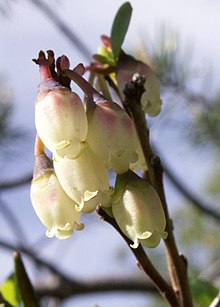
Vaccinium is a common and widespread genus of shrubs or dwarf shrubs in the heath family (Ericaceae). The fruits of many species are eaten by humans and some are of commercial importance, including the cranberry, blueberry, bilberry (whortleberry), lingonberry (cowberry), and huckleberry. Like many other ericaceous plants, they are generally restricted to acidic soils.

Vaccinium vitis-idaea, the lingonberry, partridgeberry, mountain cranberry or cowberry, is a small evergreen shrub in the heath family Ericaceae, that bears edible fruit. It is native to boreal forest and Arctic tundra throughout the Northern Hemisphere, from Europe and Asia to North America. Lingonberries are picked in the wild and used to accompany various dishes, primarily in the Nordic countries. Commercial cultivation is undertaken in the U.S. Pacific Northwest and in the Netherlands.
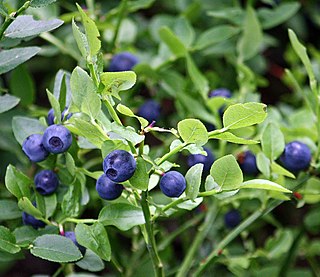
Bilberries or blueberries are Eurasian low-growing shrubs in the genus Vaccinium in the flowering plant family Ericaceae), that bear edible, dark blue berries. The species most often referred to is Vaccinium myrtillus L., but there are several other closely related species.
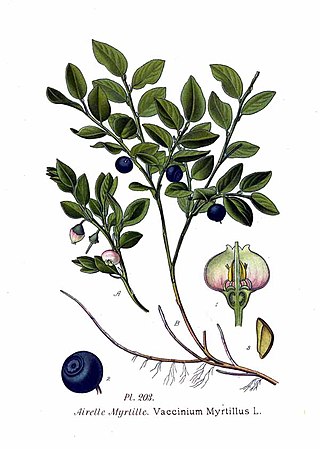
Vaccinium myrtillus or European blueberry is a holarctic species of shrub with edible fruit of blue color, known by the common names bilberry, blaeberry, wimberry, and whortleberry. It is more precisely called common bilberry or blue whortleberry to distinguish it from other Vaccinium relatives.
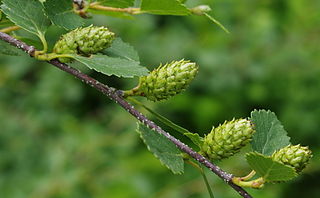
Betula glandulosa, the American dwarf birch, also known as resin birch or shrub birch, is a species of birch native to North America.

Vaccinium myrtilloides is a shrub with common names including common blueberry, velvetleaf huckleberry, velvetleaf blueberry, Canadian blueberry, and sourtop blueberry. It is common in much of North America, reported from all 10 Canadian provinces plus Nunavut and Northwest Territories, as well as from the northeastern and Great Lakes states in the United States. It is also known to occur in Montana and Washington.

Vaccinium parvifolium, the red huckleberry, is a species of Vaccinium native to western North America.

Ostrya virginiana, the American hophornbeam, is a species of Ostrya native to eastern North America, from Nova Scotia west to southern Manitoba and eastern Wyoming, southeast to northern Florida and southwest to eastern Texas. Populations from Mexico and Central America are also regarded as the same species, although some authors prefer to separate them as a distinct species, Ostrya guatemalensis. Other names include eastern hophornbeam, hardhack, ironwood, and leverwood.
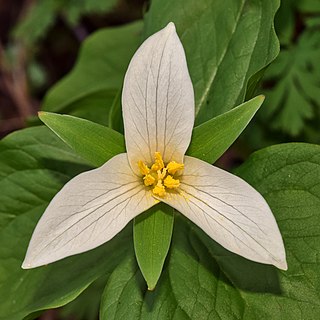
Trillium ovatum, the Pacific trillium, also known as the western wakerobin, western white trillium, or western trillium, is a species of flowering plant in the family Melanthiaceae. It is found in western North America, from southern British Columbia and the tip of southwestern Alberta to central California, east to Idaho and western Montana. There is an isolated population in northern Colorado and southern Wyoming.

Dudleya abramsiisubsp. setchellii, known by common name as the Santa Clara Valley dudleya or Santa Clara Valley liveforever, is a member of the Dudleya genus of succulent perennials, members of the family Crassulaceae. The Santa Clara Valley dudleya, endemic to the Santa Clara Valley region in the southern San Francisco Bay Area, was listed on 3 February 1995, as an endangered species. It is considered to be a subspecies of Dudleya abramsii, but its taxonomic status is still unclear. Its closest relative is Dudleya cymosa subsp. paniculata, which is a morphologically similar sister taxon.

Empetrum nigrum, crowberry, black crowberry, or, in western Alaska, blackberry, is a flowering plant species in the heather family Ericaceae with a near circumboreal distribution in the Northern Hemisphere. It is usually dioecious, but there is a bisexual tetraploid subspecies, Empetrum nigrum subsp. hermaphroditum, which occurs in more northerly locations and at higher altitude.
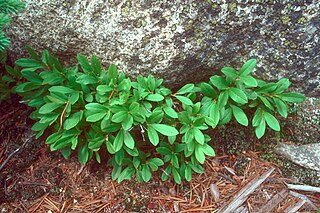
Vaccinium cespitosum, known as the dwarf bilberry, dwarf blueberry, or dwarf huckleberry, is a species of flowering shrub in the genus Vaccinium, which includes blueberries, huckleberries, and cranberries.
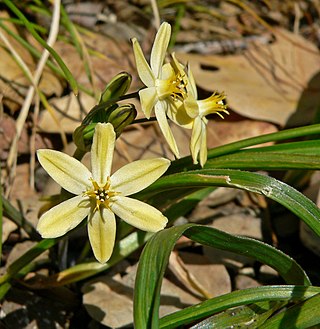
Triteleia ixioides, known as prettyface or golden star, is a monocotyledon flowering plant in the genus Triteleia. It is native to northern and central California and southwestern Oregon, where it can be found in coastal and inland coniferous forests and other habitat. It is a perennial wildflower growing from a corm. It produces one to two basal leaves up to 50 centimeters long by 1.5 wide. The inflorescence arises on an erect stem up to 80 centimeters tall. It is an umbel-like cluster of several flowers each borne on a pedicel up to 7 centimeters long. The flowers are variable in size, measuring one to nearly three centimeters in length. They are pale to bright yellow, or sometimes purple-tinged white. There are six tepals with darker midveins in shades of green, brown, or purple. The lobes are funnel-shaped and may open flat or somewhat reflexed. The six stamens form a fused tube that protrudes from the corolla; they have broad, flat filaments and whitish, yellowish, or blue anthers.
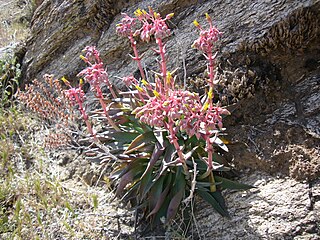
Dudleya saxosa is a perennial succulent plant species in the family Crassulaceae, within the genus Dudleya, which are commonly known as liveforevers. This species is a complex of 3 subspecies of plants, isolated and disjunct in distribution from one another, each with varying levels of ploidy and morphology. One plant is native throughout the deserts and mountains of Southern California, another is found in the Panamint Mountains, and one is found throughout central Arizona.
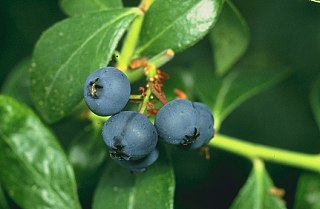
Blueberry is a widely distributed and widespread group of perennial flowering plant with blue or purple berries. They are classified in the section Cyanococcus within the genus Vaccinium. Vaccinium also includes cranberries, bilberries, huckleberries and Madeira blueberries. Commercial blueberries—both wild (lowbush) and cultivated (highbush)—are all native to North America. The highbush varieties were introduced into Europe during the 1930s.

Vaccinium ovalifolium is a plant in the heath family with three varieties, all of which grow in northerly regions.

Lycopodiella inundata is a species of club moss known by the common names inundated club moss, marsh clubmoss and northern bog club moss. It has a circumpolar and circumboreal distribution, occurring throughout the northern Northern Hemisphere from the Arctic to montane temperate regions in Eurasia and North America. It grows in wet habitat, such as bogs, ponds, moist spots on the tundra, and long-standing borrow pits.

Carex bigelowii is a species of sedge known by the common names Bigelow's sedge, Gwanmo sedge, and stiff sedge. It has an Arctic–alpine distribution in Eurasia and North America, and grows up to 50 centimetres (20 in) tall in a variety of habitats.

Vaccinium pallidum is a species of flowering plant in the heath family known by the common names hillside blueberry, Blue Ridge blueberry, late lowbush blueberry, and early lowbush blueberry. It is native to central Canada (Ontario) and the central and eastern United States plus the Ozarks of Missouri, Arkansas, southeastern Kansas and eastern Oklahoma.

Vaccinium oxycoccos is a species of flowering plant in the heath family. It is known as small cranberry, marshberry, bog cranberry, swamp cranberry, or, particularly in Britain, just cranberry. It is widespread throughout the cool temperate northern hemisphere, including northern Europe, northern Asia and northern North America.

